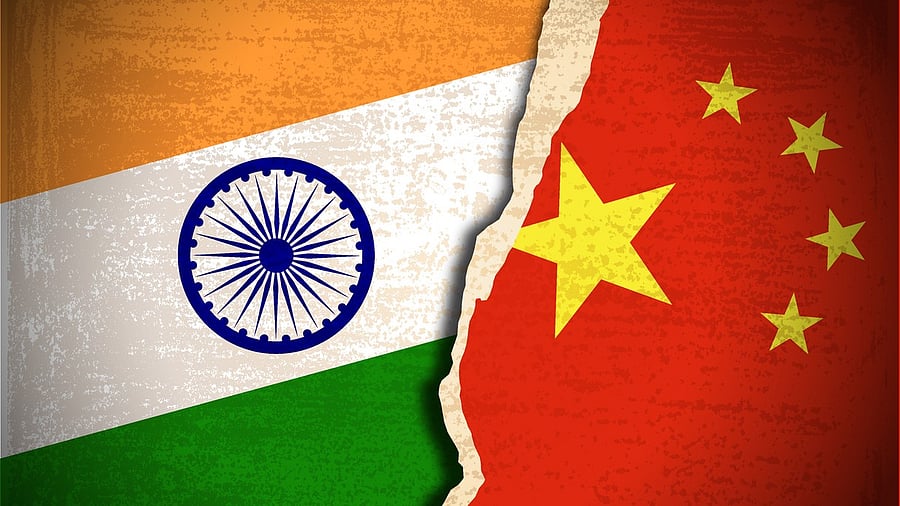
Image showing flags of India and China. For representational purposes.
Credit: iStock Photo
India and China are moving towards normalising bilateral relations following an almost five-year-long chill, which began after the June 2020 Galwan crisis. Chinese Vice Minister for Foreign Affairs Sun Weidong met with Foreign Secretary Vikarm Misri in India. The Kailash Mansarovar Yatra has resumed, and the resumption of direct flights is likely. Defence Minister Rajnath Singh attended the SCO meeting in China. On the sidelines, he also met his Chinese counterpart, Admiral Dong Jun and proposed a four-point roadmap on the border dispute.
China’s softened approach towards India is partly driven by the ongoing trade war with the United States. China is seriously looking to reset its troubled relations in the neighbourhood, and to diversify its export markets. Operation Sindoor and its aftermath do influence the direction of India-China relations. More importantly, US President Donald Trump’s hegemonic and unilateral ways of interfering in conflicts would curtail China’s ambitions in the immediate neighbourhood and extended Asia.
Quite often, the Chinese public vocabulary about India is a softer version of what it expects from India. Once again, conversations have started around India and China’s civilisational connections to suggest that people-to-people ties can be the bedrock of the bilateral relations. However, India and China don’t have a real people-to-people connect. In general, there is a limited intrinsic rationale to stable bilateral relations, and external actors influence the relations.
Even before Galwan, despite broadening social and economic engagements, India-China ties were marked by cyclical ups and downs. Important visits lead to stability, and it was followed by incidents on the border that lead to tensions. This is especially true in the Xi Jinping era. India’s and China’s working mechanisms and norms of border management and engagement have not worked because New Delhi has had to deal with a more confident and paranoid Beijing; it is confident because its power is growing, and it is paranoid because it sees the world in a conspiracy against its rising power and status.
China refuses to acknowledge India’s independent power or position, and sees India as a cog in the US’ game in Asia. In addition, India’s border infrastructure has improved over the last several years which has increased the chances of the troops coming face to face. In future, climate change, glacial melting, and landslides could lead to alteration of the border point and potentially create more chances of friction. This pattern of incidents can be stopped only through a sustained strategic dialogue.
An important undiscussed arena in the India-China contest is the Indian Ocean. India is acquiring several new warships, and its offensive capacity is on the rise. China has a near-permanent presence in the Indian Ocean now, and it is an active player in the region. India and China have had two rounds, in 2016 and 2018, of maritime affairs dialogues, but none since then. This dialogue should also be resumed at the earliest, and aim to achieve a common understanding of concerns and concepts.
India and China have several dialogues aimed at confidence-building, including the Special Representatives (SR) level talks. However, other than the SR level talks, these are border-management-related mechanisms and not strategic conversations. There is also a perception that these talks tend to be centred on border management rather than contributing to any progress on the settlement of the actual dispute. Thus, there is a vacuum of a genuine dialogue that focuses on understanding mutual deterrence concepts, worldviews, expectations, and redlines of each other.
In international relations, as perceptions shape reality, perceptions and militarisation make the images of the worst-case scenario appear more viable. States overestimate the opponent’s capacity and will, leading to pre-emptive strategies, and fear becomes the central driver of a state’s choices.
Perhaps the most significant aspect of India-China ties is their nuclear strategies and what it means for each other. The recent increase in China’s warhead stockpiles, as well as its technological advancement and ambiguity over its no-first-use policy, have pushed some Indian experts to suggest a reassessment of India’s own nuclear posture. A related question is whether the two countries attach the same meaning to concepts like deterrence, coercion, and compellence. On several occasions, experts have recommended that the two countries develop a shared glossary of strategic keywords. This initiative has been a non-starter for several reasons, but if developed, it can be highly useful.
This is not to say that India and China are destined to fight or that distrust will be permanent. However, to break out of the cyclical pattern in the ties, India and China need to institutionalise a dialogue mechanism that is centred on discussing deterrence, including nuclear deterrence. Finally, this dialogue must be permanent and weatherproof, so that it is not hampered by episodic crises.
(Avinash Godbole is Professor and Associate Academic Dean, JSLH, JGU. Views expressed are personal. X: @avingodb.)
Disclaimer: The views expressed above are the author's own. They do not necessarily reflect the views of DH.